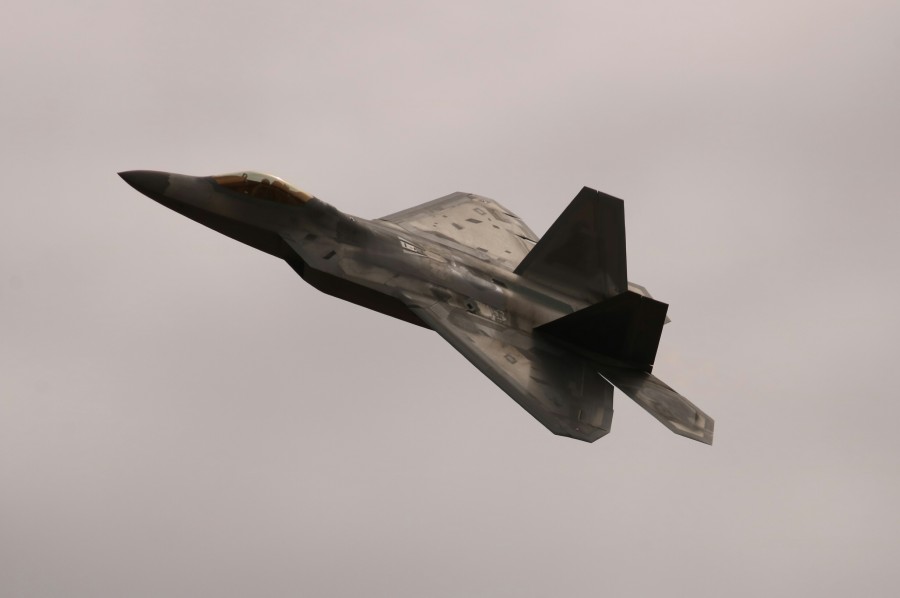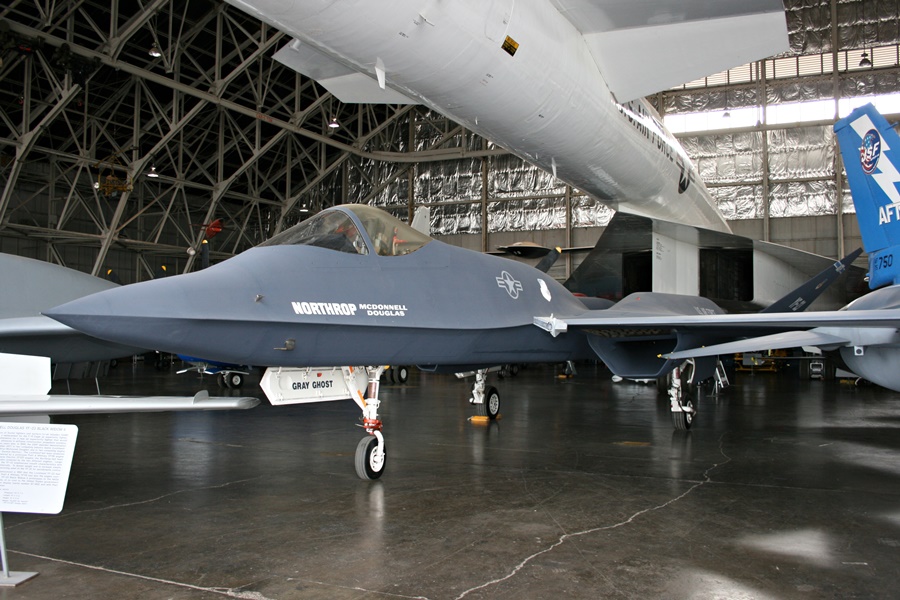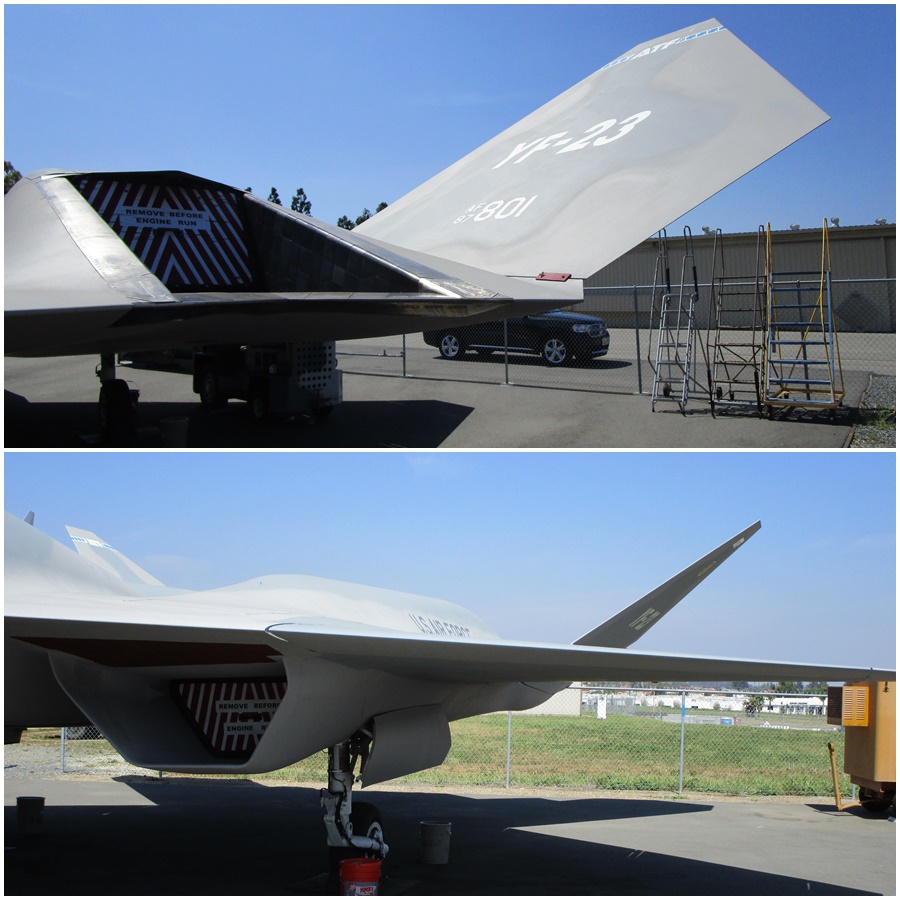The USAF Advanced Tactical Fighter (ATF) Program commenced in the 1970’s, then continued through the 1980’s and 1990’s, as a development, demonstration and evaluation program for a new USAF fifth generation fighter with stealth technology to complement and eventually replace the McDonnell Douglas F-15 Eagle air superiority fighter. Lockheed and Northrop proposals were accepted in October 1986 and the competition was between the Lockheed YF-22A “Lightning II” (later allocated to the Lockheed Martin F-35A Joint Strike Fighter) and Northrop-McDonnell Douglas YF-23A, unofficially nicknamed by Northrop staff as the “Black Widow II“. After years of flight testing, the ultimate winner was announced as the YF-22A in August 1991.

The ATF Program itself evolved from military developments in Europe in the 1970’s where the Soviet Union was developing advanced new combat aircraft designs such as the future Mikoyan Gurevich MiG-29 Fulcrum and Sukhoi Su-27 Flanker which were then expected (rightfully) to be at least the equal in combat of then current and incoming USAF aircraft. The ATF was planned to incorporate full digital flight control and engine management systems, composite materials, lightweight alloys, powerful engines with supercruise capability (prolonged supersonic flight without the use of afterburners) and stealth technology such as radar deflective/absorbing design and materials (including radar absorbent paint), and internal weapons bays for short and medium range air-to-air missiles.
The Advanced Tactical Fighter was originally intended to provide a future advanced fighter designed both for air superiority and a strike role to replace many aircraft types either just coming into service or already operational. The first specifications document was released in January 1973. The USAF requirement for thrust reversers was dropped in 1987 due to the extra weight and complexity this would add to the aircraft design – they were intended to reduce speed in flight during combat, control speed during landing and reduce the landing distance required upon touchdown.
It was later determined the strike role could be adequately covered by aircraft like the General Dynamics F-16A Fighting Falcon (operational 1978), Lockheed F-117A Nighthawk “Stealth Fighter” (1983) and McDonnell Douglas F-15E Strike Eagle (1989), so the focus switched to the ATF primarily conducting air to air missions with the aim to eventually replace the McDonnell Douglas F-15C Eagle air superiority fighter. With stealth technology, the program was not looking just for air superiority but total air dominance!

As with the Northrop YF-17 Cobra “F-18 Prototype” that lead to the McDonnell Douglas F/A-18A Hornet multi-role fighter, Northrop partnered with McDonnell Douglas again to develop the Northrop-McDonnell Douglas YF-23A for the ATF Program. Two prototypes were built – YF-23A 87-0800 (N231YF) Prototype Air Vehicle 1 (PAV-1) and YF-23A 87-0801 (N232YF) Prototype Air Vehicle 2 (PAV-2). Prototype 87-0800 conducted its first flight under the control of test pilot Alfred “Paul” Metz on August 27th, 1990 and 87-0801 was first flown by Jim Sandberg on October 26th, 1990.
The first YF-23A prototype originally featured a dark charcoal livery and was given the call sign “Gray Ghost”. The second prototype was painted in a two-tone grey scheme and had the call sign “Spider“.

The YF-22A was developed in partnership by Lockheed, Boeing and General Dynamics for the ATF Program. Two prototypes were also built – YF-22A 87-0700 and YF-22A 87-0701. The first prototype flew on September 29th, 1990 with test pilot David L. Ferguson at the controls. The second prototype flew for the first time on October 30th, 1990, piloted by Tom Morgenfeld.

The first YF-22A and YF-23A prototypes were powered by a pair of newly developed 35,000 lbs thrust Pratt & Whitney YF119-PW-100 afterburning augmented turbofan engines with an advanced fuel control system and a capability to go supersonic without afterburner. The prototypes had a top speed of approximately Mach 2.0 (classified). The second prototypes were fitted with a different pair of new engines for evaluation purposes – the more advanced 35,000 lbs thrust General Electric YF120-GE-100 afterburning engine that operated as a turbofan at subsonic speeds and a turbojet at supersonic speeds. Ultimately the F-22A Raptor was fitted with production F119 engines which were determined to have less technological risks.
During the ATF Program flight test evaluations the YF-22A prototypes completed 74 flights with 91.6 flying hours. The YF-23A prototypes completed 50 flights with 65.2 flying hours. Flight testing concluded on December 28th, 1990.
The longer, more slender YF-23A was reportedly the better stealth aircraft (especially from the side and rear) as the YF-22A had a larger radar cross-section. The YF-23A was slightly faster but the YF-22A was more agile and maneuverable.
The YF-22A utilised engine vector thrust for extreme maneuverability in air combat. To save weight and increase its stealth capability, the YF-23A featured fixed engine nozzles without vector thrust but had a unique engine heat diffusing system of special heat abating tiles around exhaust ports that sat well forward and atop of the fuselage to reduce the heat signature and intake S-ducts to shield engine axial compressors from radar detection. The YF-22A air inlets curved upwards and inwards and it also had S-ducts to shield the engine intakes from radar detection.
To save costs, the YF-23A was a bare bones prototype with no complex avionics or radar installed and it was fitted with the nose gear and cockpit avionics of the F-15 Eagle and the main landing gear from the F/A-18A Hornet. Only one weapons bay was installed just behind the nose gear on the prototype – it could accommodate four AIM-120 AMRAAM medium range air-to-air missiles but no weapons systems were actually installed. It was planned that the production aircraft would also be slightly stretched to accommodate another weapons bay for short-range air-to-air missiles in front of the main bay.
The YF-22A also did not have a radar fitted but had three active weapons bays – one on each side of the fuselage for a single short-range AIM-9 Sidewinder missile and the main bay in the belly of the fighter for up to six AIM-120 AMRAAM missiles. None of the prototypes were fitted with cannon armament.
Northrop did not design the YF-23A prototype to conduct missile tests or high angle of attack tests during the test flight program but although the YF-22A was not fitted with a radar, they did conduct live firing tests of AIM-9 Sidewinder and AIM-120 AMRAAM air-to-air missiles from internal weapons bays and completed high angle of attack test flights (60°), which probably also helped it out in selection due to its program combat readiness status. The YF-23A design was probably also too radical for the time, featuring an unconventional drag reducing fuselage profile, diamond wing design and all moving two tail surfaces (V tail) compared to the more standard four surfaces of the YF-22A!
While the YF-23A had a longer, lower, wider looking fuselage profile and streamlined flowing surfaces that reportedly made it more stealth capable (especially from ground based radar), in aerial photos it still seems too chunky with bumps all over it, yet standing next to one from ground level it looks very streamlined – A fascinating aircraft! To me though, the YF-22A seems more sleek and fighter plane like in the air and on the ground. The rest is history…
F-22A Raptor
The YF-22A prototype became the highly advanced Lockheed Martin F-22A Raptor air dominance fighter which finally entered operational USAF service in 2005 and remains the benchmark operational fifth generation fighter today. The original ATF Program called for 750 aircraft at a total cost of $64.3 billion USD but the end of the Cold War meant no where this number would be required and with budgetary constraints along with political and strategic changes, it was reduced over the years to 648 in 1990, then 339 in 1997, 277 by 2003 and just 183 in 2004 with a program cost of $62 billion USD!
The USAF stated it would prefer 381 F-22A aircraft to cover operational requirements – in 2008 Congress raised the official order to only 187 operational F-22A aircraft (plus 8 test aircraft) – production ran from 1996 to 2011, with the last entering USAF service in 2012. This seems to have been a huge mistake in the current world political climate and days of an ageing F-15 Eagle fleet but the F-22 production lines are long closed! As of 2010 the reported program cost was $67.3 billion (USD) with a unit cost of $150 million per aircraft (the economies of scale for mass production predicted in the original ATF Program were never reached).

Due to the top advanced technology and design involved, the development of an F-22A export variant were not permitted by the US Government, even for allies such as Australia, Israel and Japan! These nations are now operators of the Lockheed Martin F-35A Lightning II Joint Strike Fighter.
YF-23A Survivors
The two Northrop-McDonnell Douglas YF-23A prototypes survive today. Both were retired at the end of the ATF Program and were transferred without engines to the NASA Dryden Flight Research Center at Edwards AFB, California for further airframe testing that did not eventuate. The prototypes were kept in storage until 1996 but are now on display in aviation museums in the United States.
The YF-23A almost got a second life in 2004, when Northrop offered a modified version to meet a USAF interim bomber proposal, that unfortunately did not progress and the USAF decided to use long-range bombers instead – Northrop modified the second YF-23A prototype for ground based demonstration purposes for the proposal. Although Northrop did not have any success with their fighter prototypes they have dominated the stealth bomber market for the USAF, with their flying wing design Northrop Grumman B-2A Spirit (21 built, with 20 still in service since 1997) and the future B-21 Raider that is currently in development.
National Museum of the United States Air Force
YF-23A 87-0800 (N231YF) PAV-1 “Gray Ghost” is on display at the National Museum of the United States Air Force in Dayton, Ohio. When I saw the aircraft in 2009 it was on display at the museum but in the Research and Development Hangar that was part of the Wright Patterson Air Force Base and you required official identification to be able to take the tour to the base hangar. I wish I had taken more photos back then but you were on a short time frame as it was part of the active base!




Western Museum of Flight
YF-23A 87-0801 (N232YF) PAV-2 “Spider” is on display at the Western Museum of Flight in Torrance, California (on long-term loan from NASA) alongside another survivor, the Northrop YF-17 Cobra “F-18 Prototype” (72-1569). When I visited the museum in 2015, you needed to arrange an escorted visit to a secured outdoor location away from the museum on Zamperini Field (which really needs to be inside and the museum is raising funds for a restoration project).











YF-22A Survivors
The two YF-22A prototypes are not as easy to see in person as the YF-23A survivors (unlike the latter, to date I have not personally seen either of the YF-22A’s). YF-22A 87-0700 was retired after the ATF Program and is part of the Air Force Flight Test Center Museum collection at Edwards Air Force Base in California. YF-22A 87-0701 continued to be used as a flight test aircraft by Lockheed after the ATF Program concluded (39 test flights with 61.6 flying hours) but was damaged in a landing accident and is now used as a ground based test aircraft.
This was another of my “lost articles” that was meant to be posted back in 2015. Better late than never! This blog was originally posted on Aces Flying High – The Survivors on April 24th, 2019.
References:
Congressional Research Service – Potential F-22 Raptor Export to Japan
Joe Baugher – Lockheed Martin F-22 Raptor
Joe Baugher – Northrop/McDonnell Douglas YF-23
National Museum of the USAF Fact Sheet – Pratt & Whitney YF119-PW-100L Augmented Turbofan
National Museum of the USAF Fact Sheet – Lockheed-Boeing-General Dynamics YF-22A
National Museum of the USAF Fact Sheet – Northrop-McDonnell Douglas YF-23A Black Widow II
Western Museum of Flight – Northrop YF-23A Black Widow II

amazing technology resulted from those prototypes
LikeLiked by 2 people
Game changers
LikeLike